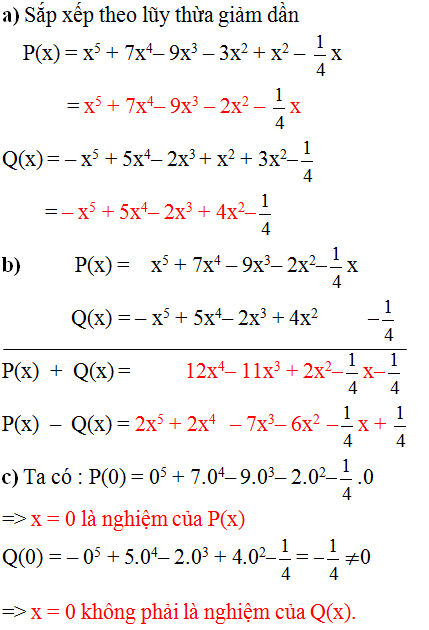Hãy nhập câu hỏi của bạn vào đây, nếu là tài khoản VIP, bạn sẽ được ưu tiên trả lời.

I . Trắc Nghiệm
1B . 2D . 3C . 5A
II . Tự luận
2,a,Ta có: A+(x\(^2\)y-2xy\(^2\)+5xy+1)=-2x\(^2\)y+xy\(^2\)-xy-1
\(\Leftrightarrow\) A=(-2x\(^2\)y+xy\(^2\)-xy-1) - (x\(^2\)y-2xy\(^2\)+5xy+1)
=-2x\(^2\)y+xy\(^2\)-xy-1 - x\(^2\)y+2xy\(^2\)-5xy-1
=(-2x\(^2\)y - x\(^2\)y) + (xy\(^2\)+ 2xy\(^2\)) + (-xy - 5xy ) + (-1 - 1)
= -3x\(^2\)y + 3xy\(^2\) - 6xy - 2
b, thay x=1,y=2 vào đa thức A
Ta có A= -3x\(^2\)y + 3xy\(^2\) - 6xy - 2
= -3 . 1\(^2\) . 2 + 3 .1 . 2\(^2\) - 6 . 1 . 2 -2
= -6 + 12 - 12 - 2
= -8
3,Sắp xếp
f(x) =9-x\(^5\)+4x-2x\(^3\)+x\(^2\)-7x\(^4\)
=9-x\(^5\)-7x\(^4\)-2x\(^3\)+x\(^2\)+4x
g(x) = x\(^5\)-9+2x\(^2\)+7x\(^4\)+2x\(^3\)-3x
=-9+x\(^5\)+7x\(^4\)+2x\(^3\)+2x\(^2\)-3x
b,f(x) + g(x)=(9-x\(^5\)-7x\(^4\)-2x\(^3\)+x\(^2\)+4x) + (-9+x\(^5\)+7x\(^4\)+2x\(^3\)+2x\(^2\)-3x)
=9-x\(^5\)-7x\(^4\)-2x\(^3\)+x\(^2\)+4x-9+x\(^5\)+7x\(^4\)+2x\(^3\)+2x\(^2\)-3x
=(9-9)+(-x\(^5\)+x\(^5\))+(-7x\(^4\)+7x\(^4\))+(-2x\(^3\)+2x\(^3\))+(x\(^2\)+2x\(^2\))+(4x-3x)
= 3x\(^2\) + x
g(x)-f(x)=(-9+x\(^5\)+7x\(^4\)+2x\(^3\)+2x\(^2\)-3x) - (9-x\(^5\)-7x\(^4\)-2x\(^3\)+x\(^2\)+4x)
=-9+x\(^5\)+7x\(^4\)+2x\(^3\)+2x\(^2\)-3x-9+x\(^5\)+7x\(^4\)+2x \(^3\)-x\(^2\)-4x
=(-9-9)+(x\(^5\)+x\(^5\))+(7x\(^4\)+7x\(^4\))+(2x\(^3\)+2x\(^3\))+(2x\(^2\)-x\(^2\))+(3x-4x)
= -18 + 2x\(^5\) + 14x\(^4\) + 4x\(^3\) + x\(^2\) - x

I . Trắc Nghiệm 1B . 2D . 3C . 5A II . Tự luận 2,a,Ta có: A+(x22y-2xy22+5xy+1)=-2x22y+xy22-xy-1 ⇔⇔ A=(-2x22y+xy22-xy-1) - (x22y-2xy22+5xy+1) =-2x22y+xy22-xy-1 - x22y+2xy22-5xy-1 =(-2x22y - x22y) + (xy22+ 2xy22) + (-xy - 5xy ) + (-1 - 1) = -3x22y + 3xy22 - 6xy - 2 b, thay x=1,y=2 vào đa thức A Ta có A= -3x22y + 3xy22 - 6xy - 2 = -3 . 122 . 2 + 3 .1 . 222 - 6 . 1 . 2 -2 = -6 + 12 - 12 - 2 = -8 3,Sắp xếp f(x) =9-x55+4x-2x33+x22-7x44 =9-x55-7x44-2x33+x22+4x g(x) = x55-9+2x22+7x44+2x33-3x =-9+x55+7x44+2x33+2x22-3x b,f(x) + g(x)=(9-x55-7x44-2x33+x22+4x) + (-9+x55+7x44+2x33+2x22-3x) =9-x55-7x44-2x33+x22+4x-9+x55+7x44+2x33+2x22-3x =(9-9)+(-x55+x55)+(-7x44+7x44)+(-2x33+2x33)+(x22+2x22)+(4x-3x) = 3x22 + x g(x)-f(x)=(-9+x55+7x44+2x33+2x22-3x) - (9-x55-7x44-2x33+x22+4x) =-9+x55+7x44+2x33+2x22-3x-9+x55+7x44+2x 33-x22-4x =(-9-9)+(x55+x55)+(7x44+7x44)+(2x33+2x33)+(2x22-x22)+(3x-4x) = -18 + 2x55 + 14x44 + 4x33 + x22 - x

Câu 1: Tìm nghiệm của các đa thức:
1. P(x) = 2x -3
⇒2x-3=0
↔2x=3
↔x=\(\frac{3}{2}\)
2. Q(x) = −12−12x + 5
↔-12-12x+5=0
↔-12x=0+12-5
↔-12x=7
↔x=\(\frac{7}{-12}\)
3. R(x) = 2323x + 1515
↔2323x+1515=0
↔2323x=-1515
↔x=\(\frac{-1515}{2323}\)
4. A(x) = 1313x + 1
↔1313x + 1=0
↔1313x=-1
↔x=\(\frac{-1}{1313}\)
5. B(x) = −34−34x + 1313
↔−34−34x + 1313=0
↔-34x=0+34-1313
↔-34x=-1279
↔x=\(\frac{1279}{34}\)
Câu 2: Chứng minh rằng: đa thức x2 - 6x + 8 có hai nghiệm số là 2 và 4
Giải :cho x2 - 6x + 8 là f(x)
có:f(2)=22 - 6.2 + 8
=4-12+8
=0⇒x=2 là nghiệm của f(x)
có:f(4)=42 - 6.4 + 8
=16-24+8
=0⇒x=4 là nghiệm của f(x)
Câu 3: Tìm nghiệm của các đa thức sau:
1.⇒ (2x - 4) (x + 1)=0
↔2x-4=0⇒2x=4⇒x=2
x+1=0⇒x=-1
-kết luận:x=2 vàx=-1 là nghiệm của A(x)
2. ⇒(-5x + 2) (x-7)=0
↔-5x + 2=0⇒-5x=-2⇒
x-7=0⇒x=7
-kết luận:x=\(\frac{2}{5}\)và x=7 là nghiệm của B(x)
3.⇒ (4x - 1) (2x + 3)=0
⇒4x-1=0↔4x=1⇒x=\(\frac{1}{4}\)
2x+3=0↔2x=3⇒x=\(\frac{3}{2}\)
-kết luận:x=\(\frac{1}{4}\)và x=\(\frac{3}{2}\) là nghiệm của C(x)
4. ⇒ x2- 5x=0
↔x.x-5.x=0
↔x.(x-5)=0
↔x=0
x-5=0⇒x=5
-kết luận:x=0 và x=5 là nghiệm của D(x)
5. ⇒-4x2 + 8x=0
↔-4.x.x+8.x=0
⇒x.(-4x+x)=0
⇒x=0
-4x+x=0⇒-3x=0⇒x=0
-kết luận:x=0 là nghiệm của E(x)
Câu 4: Tính giá trị của:
1. f(x) = -3x4 + 5x3 + 2x2 - 7x + 7 tại x = 1; 0; 2
-X=1⇒f(x) =4
-X=0⇒f(x) =7
-X=2⇒f(x) =89
2. g(x) = x4 - 5x3 + 7x2 + 15x + 2 tại x = -1; 0; 1; 2
-X=-1⇒G(x) =-14
-X=0⇒G(x) =2
-X=1⇒G(x) =20
-X=2⇒G(x) =43

a. P(x)+Q(x)=(3x4 + x3- x2- \(\dfrac{1}{4}\)x)+(3x4- 4x3+x2-\(\dfrac{1}{4}\))=6x4-3x3+\(\dfrac{1}{2}\)
Tương tự làm P(x)-Q(X) nhé !!!
b. Thay x = 0 vào đa thức P(x) ta có :
.....................................................
thay x = 0 vào đa thức Q(x) ta có:
......................................................
=> đpcm

Bài 1:
a) Để tìm nghiệm của đa thức \(\left(x-3\right)\left(4-5x\right)\), ta cho đa thức \(\left(x-3\right)\left(4-5x\right)=0\).
\(\Leftrightarrow\left[{}\begin{matrix}x-3=0\\4-5x=0\end{matrix}\right.\Leftrightarrow\left[{}\begin{matrix}x=3\\5x=4\end{matrix}\right.\Leftrightarrow\left[{}\begin{matrix}x=3\\x=\dfrac{4}{5}\end{matrix}\right.\)
Vậy nghiệm của đa thức \(\left(x-3\right)\left(4-5x\right)\) là \(3\) và \(\dfrac{4}{5}\).
b) Để tìm nghiệm của đa thức \(x^2-2\), ta cho đa thức \(x^2-2=0\).
\(\Leftrightarrow x^2=2\) \(\Leftrightarrow\left[{}\begin{matrix}x=-\sqrt{2}\\x=\sqrt{2}\end{matrix}\right.\)
Vậy nghiệm của đa thức \(x^2-2\) là \(-\sqrt{2}\) và \(\sqrt{2}\).
c) Để tìm nghiệm của đa thức \(x^2+\sqrt{3}\), ta cho đa thức \(x^2+\sqrt{3}=0\).
\(\Leftrightarrow x^2=-\sqrt{3}\)
Vì \(x^2\ge0\) với mọi \(x\)
nên \(x^2>-\sqrt{3}\)
Vậy đa thức \(x^2+\sqrt{3}\) vô nghiệm.
d) Để tìm nghiệm của đa thức \(x^2+2x\), ta cho đa thức \(x^2+2x=0\).
\(\Leftrightarrow x\times\left(x+2\right)=0\) \(\Leftrightarrow\left[{}\begin{matrix}x=0\\x+2=0\end{matrix}\right.\Leftrightarrow\left[{}\begin{matrix}x=0\\x=-2\end{matrix}\right.\)
Vậy nghiệm của đa thức \(x^2+2x\) là \(0\) và \(-2\).
e) Để tìm nghiệm của đa thức \(x^2+2x-3\), ta cho đa thức \(x^2+2x-3=0\).
\(\Leftrightarrow x^2+2x=3\) \(\Leftrightarrow x^2+x+x+1=3+1\) \(\Leftrightarrow x\times\left(x+1\right)+\left(x+1\right)=4\) \(\Leftrightarrow\left(x+1\right)\left(x+1\right)=4\) \(\Leftrightarrow\left(x+1\right)^2=4\) \(\Leftrightarrow\left[{}\begin{matrix}x+1=-2\\x+1=2\end{matrix}\right.\Leftrightarrow\left[{}\begin{matrix}x=-3\\x=1\end{matrix}\right.\)
Vậy nghiệm của đa thức \(x^2+2x-3\) là \(-3\) và \(1\).
Bài 2:
a) Ta có: \(f\left(x\right)=x\left(1-2x\right)+\left(2x^2-x+4\right)\) \(=x-2x^2+2x^2-x+4\) \(=\left(-2x^2+2x^2\right)+\left(x-x\right)+4=4\)
Vì \(f\left(x\right)=4\) với mọi \(x\)
nên \(f\left(x\right)>0\) với mọi \(x\)
Vậy đa thức \(f\left(x\right)\) vô nghiệm.
b) Ta có: \(g\left(x\right)=x\left(x-5\right)-x\left(x+2\right)+7x=x^2-5x-x^2-2x\) \(=\left(x^2-x^2\right)-\left(5x+2x\right)=-7x\)
Để tìm nghiệm của đa thức \(g\left(x\right)\), ta cho đa thức \(g\left(x\right)=0\).
\(\Leftrightarrow-7x=0\Leftrightarrow x=0\)
Vậy nghiệm của đa thức \(g\left(x\right)\) là \(0\).
c) Theo đề bài, ta có: \(h\left(x\right)=x\left(x-1\right)+1\) (Đa thức này đã được thu gọn)
Để tìm nghiệm của đa thức \(h\left(x\right)\), ta cho đa thức \(h\left(x\right)=0\).
\(\Leftrightarrow x\left(x-1\right)+1=0\Leftrightarrow x\left(x-1\right)=-1\)
\(\Rightarrow x\inƯ\left(-1\right)=\left\{-1;1\right\}\)
Ta có bảng sau:
| \(x\) | \(-1\) | \(1\) |
| \(x-1\) | \(-2\) | \(0\) |
| \(x\left(x-1\right)\) | \(2\) (loại) | \(0\) (loại) |
Vậy đa thức \(h\left(x\right)\) vô nghiệm.

b,x=15/4laf nghiệm của đa thức trên
bai 2
a,x=1/2
b,x thuộc(3/4,-5)
c,x= căn bậc 2 cuả 2

\(C\left(x\right)=\frac{4x-3}{6}-\frac{5-3x}{3}+\frac{1}{3}\)
\(\frac{4x-3}{6}-\frac{5-3x}{3}+\frac{1}{3}=0\)
\(4x-3-2\left(5-3x\right)+2=0\)
\(4x-1-2\left(5-3x\right)=0\)
\(4x-1-10+6x=0\)
\(10x-11=0\)
\(10x=0+11\)
\(10x=11\)
\(x=\frac{11}{10}\)

a, \(P\left(x\right)=4x-\dfrac{1}{2}\)
\(\Rightarrow P\left(x\right)=4x-\dfrac{1}{2}=0\)
\(\Rightarrow x=\dfrac{1}{8}\)
b, \(Q\left(x\right)=\left(x-1\right)\left(x+1\right)\)
\(\Rightarrow Q\left(x\right)=\left(x-1\right)\left(x+1\right)=0\)
\(\Rightarrow\left[{}\begin{matrix}x-1=0\\x+1=0\end{matrix}\right.\Rightarrow\left[{}\begin{matrix}x=1\\x=-1\end{matrix}\right.\)
c, \(A\left(x\right)=x^2-7x+6\)
\(\Rightarrow A\left(x\right)=x^2-7x+6=0\)
\(\Rightarrow x^2-6x-x+6=0\)
\(\Rightarrow x\left(x-6\right)-\left(x-6\right)=0\)
\(\Rightarrow\left(x-6\right)\left(x-1\right)=0\)
\(\Rightarrow\left[{}\begin{matrix}x-6=0\\x-1=0\end{matrix}\right.\Rightarrow\left[{}\begin{matrix}x=6\\x=1\end{matrix}\right.\)
mn làm ơn giúp mik vs, thanks nhiều